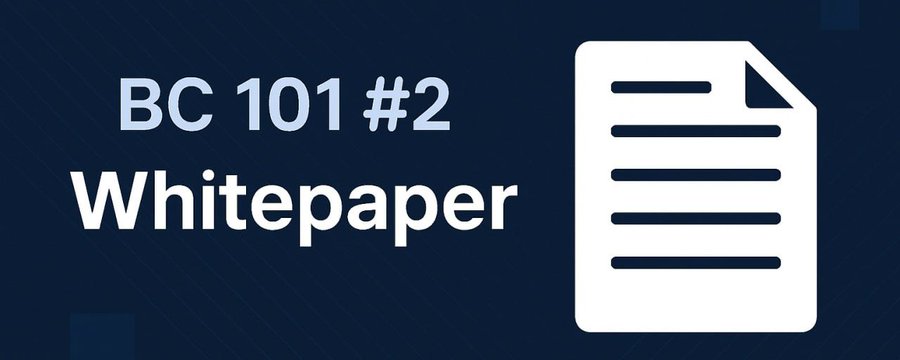https://twitter.com/aergo_io/status/1911622157588894199
Why whitepapers are more than just PDF files — and what to look for in a good one
Everyone talks about whitepapers in the crypto and blockchain world, but let’s be honest: how many people actually read them?
It’s understandable. At first glance, whitepapers can feel like the fine print of a user agreement: long and technical. But understanding its whitepaper is non-negotiable if you’re investing in, building on, or even just curious about a blockchain project.
Let’s break down what a whitepaper really is and what makes a good one.
So, What Is a Whitepaper?
A whitepaper is the blueprint of a blockchain project. It’s where founders lay out their vision, technology, goals, and the tokenomics that power the system. In other words, it’s the “why,” “how,” and “what” of the project — wrapped in a single document.
The original Bitcoin whitepaper was just nine pages long, but it changed the world. Since then, projects have followed suit, publishing whitepapers to explain how their tech works and why it matters.
What Makes a Good Whitepaper?
Not all whitepapers are created equal. Some are clear and visionary. Others? Not so much. Here’s what you should look for:
1. Clear Context: Why This Problem, and Why This Team?
A strong whitepaper doesn’t just describe a problem — it explains why this specific team or project is uniquely positioned to solve it. This context is crucial for building credibility and trust. It’s not enough to say, “X is broken, and we’re here to fix it.” The whitepaper should show:
- A deep understanding of the industry’s inner workings
- First-hand exposure to the challenges being addressed
- Clear reasoning behind the timing and relevance of the solution
Projects that lack industry experience often misidentify surface-level problems or propose solutions that aren’t technically or commercially viable. In contrast, credible teams can back their approach with real-world insights from past ventures, industry partnerships, or years spent working within the ecosystem.
Ultimately, clear context answers the questions:
- Why are these challenges real and urgent?
- Why is this team equipped to solve them better than anyone else?
- Why is blockchain the right tool for the job?
A good whitepaper makes that case — not just with big ideas but with grounded experience.
2. A Clear Problem & Solution
The best blockchain projects aren’t built just because the technology exists — they’re built to solve meaningful, often overlooked problems. A strong whitepaper begins with a clearly defined pain point. It should describe what’s broken or inefficient in the current system and explain why that matters.
But defining the problem isn’t enough. The project should offer a unique, realistic solution that adds real value.
3. Regulatory Readiness
Regulatory readiness and security are some of the clearest indicators of a project’s seriousness. Whitepapers explicitly mention smart contract audits, vulnerability testing, and attack mitigation, which shows maturity.
Look for:
- Confirmation that contracts will be audited before launch
- Mention completion of a legal classification of their token
Projects that undergo legal review, including securities law assessments like the Howey Test, proactively minimize regulatory risk, protecting themselves and their users. That’s a strong sign of long-term thinking.
4. Tokenomics That Make Sense
Tokenomics — how a token is created, distributed, and used — is arguably the economic engine of any blockchain project. Yet, many projects treat tokenomics as an afterthought or use it as a buzzword to attract speculators.
A well-designed token economy should:
- Drive real utility: Tokens should be central to the protocol’s function (e.g., used for staking, governance, access, rewards).
- Encourage long-term participation: Rather than pump-and-dump mechanics, it should reward users who stay involved and contribute to growth.
What to look for:
- Community-aligned incentives: Are tokens distributed fairly to early contributors, users, and developers — not just insiders and VCs?
- Clear allocation and vesting plans: Who gets what share, and when? Does the team’s unlock schedule align with roadmap delivery?
- Utility that drives demand: Does the token need to exist?
Tokenomics should be transparent, ideally with charts, breakdowns, and logic behind the numbers.
5. A Sustainable Business Model
Even in a decentralized world, protocols need a sustainable way to operate and grow. A whitepaper that doesn’t address long-term viability is like a startup pitch without a revenue plan.
Good whitepapers outline how the project plans to sustain itself, reward contributors, and create an ecosystem that thrives without relying solely on token price speculation or constant fundraising.
A sustainable protocol won’t just say “we’ll figure it out later.” Look for:
- Usage-based monetization models (fees on protocol usage, DAO tooling subscriptions, API calls)
- Value capture mechanisms (partner revenue shares)
An excellent whitepaper doesn’t just focus on launch mechanics. It lays the groundwork for long-term survival. Look for business models that reward contributors, attract partners, and keep the protocol economically sound even in bear markets.
Final Thoughts: It’s Not Just a PDF
Whitepapers are more than technical documents. They’re trust signals. A good whitepaper gives you confidence in the people behind the project — and a reason to believe in what they’re building.
BC 101 is a beginner-friendly series decoding blockchain, crypto, and Web3 concepts for curious minds. Stay tuned for the next one.

Добавить комментарий